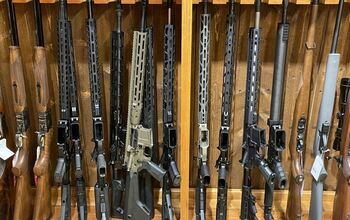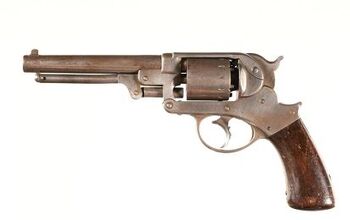We Almost Didn’t Have The PK, The Nikitin Machine Gun

The Russo-Ukraine War has unearthed another unique piece of history, particularly in the context of Soviet machine gun development. As reported by ANNA-NEWS on February 25, 2025, Russia has captured a Soviet experimental Nikitin machine gun from an arms depot belonging to the Ukrainian Armed Forces.
One notable observation about the captured weapon is that the charging handle is missing; it was designed as a separate removable component that may have broken off, lost, or been installed incorrectly. Another essential point is belt compatibility, as the Nikitin machine gun utilizes a proprietary push-through belt, which differs from previous soviet machine guns and is not compatible with the PK belts.
This machine gun was developed between 1955 and 1956 by Grigory Ivanovich Nikitin and Yuri Sokolov as part of a competition to create a general-purpose machine gun for the USSR. However, during the final stage of the competition, Mikhail Kalashnikov's design team was invited to participate, and ultimately, the PK machine gun was selected for adoption in 1961. A pilot batch of Nikitin machine guns was manufactured and tested in different regions of the Soviet Union during troop trials. After the PK was chosen, the remaining Nikitin guns were sent to museums and into storage across the former USSR, including some in Ukraine. Following the collapse of the USSR, these machine guns remained in storage until one was recently discovered during the war.
The History of the Gun
As warfare technology evolved, nations recognized the necessity of advancing their infantry capabilities, ultimately culminating in the development of machine guns. Hiram Maxim’s innovative design, created in 1884, marked the advent of the first successful machine gun, demonstrating its effectiveness during the Russo-Japanese War of 1904-1905. In the context of World War I, militaries adapted their strategies and methodologies to integrate machine guns into combat operations effectively.
Machine gun development continued during the interwar period as preparations for World War II began. Germany adopted a universal machine gun, the MG-34, and later produced the simplified MG-42.
In the mid-1940s and 1950s, after thoroughly analyzing World War II's combat experiences, many countries began developing technical requirements for new machine gun concepts. The armies of most nations adopted the German idea of a universal machine gun or general-purpose machine gun.
The Soviet Union started developing a general-purpose machine gun after thoroughly studying German machine guns, which they found the concept appealing. By 1946, the Soviet Union issued the first requirements for a new machine gun. In 1955, updated requirements were finalized for a machine gun chambered for the 7.62x54mm cartridge that could be equipped with an integral bipod, tripod, or vehicle mount and new weight requirements of 19.8 lbs to 28 lbs. (9-13 kg).
Grigory Ivanovich Nikitin at the Tula Design Bureau developed a prototype machine gun from 1955 to 1956, designated with the factory index TKB-521.
The machine gun was gas-operated, air-cooled, and belt-fed. It featured a quick-detachable barrel and a milled receiver. It used a rotating bolt locking system, a push-through feeding system, and a self-regulating gas system, similar to the concept in the US M-60 that was developed during the same period.
The Nikitin machine gun is notable for its unique push-through feed system for the rimmed 7.62x54 cartridge. This system is achieved using an experimental non-disintegrating belt from 100- and 250-round ammunition boxes.
The development of the Nikitin system progressed slowly from 1955 to 1961, while the Kalashnikov machine gun was designed quicker—in just three years, from 1958 to 1961. A significant contributing factor to this was that the design of the PK shared many similarities with the current service rifle, the AK. This meant that much of the necessary technological equipment and tools were already available for the serial production of the Kalashnikov machine gun.
By 1958, the Nikitin design was recommended for adoption, and a pilot order of 500 to 1,000 guns produced at the Kovrov Mechanical Plant was placed for field trials with troops. Due to the slow development of the Nikitin machine gun, the Soviet Army sought to speed up the process by introducing Mikhail Kalashnikov's design team to create a competing design.
In conclusion, if the Nikitin machine gun had worked more quickly, Russia may have had a different general-purpose machine gun, and we may not know about the PK machine gun. This would have significantly influenced Soviet small arms in a different direction than we see today.
Sources:
Weapons of Heroes | Virtual Museum of Tula State Museum of Weapons

Lynndon Schooler is an open-source weapons intelligence professional with a background as an infantryman in the US Army. His experience includes working as a gunsmith and production manager in firearm manufacturing, as well as serving as an armorer, consultant, and instructor in nonstandard weapons. His articles have been published in Small Arms Review and the Small Arms Defence Journal. https://www.instagram.com/lynndons
More by Lynndon Schooler





























Comments
Join the conversation
I like the overall short height of the gun. Makes the PK/PKM look chunky in comparison. It appears that the rear sight is fixed to the receiver instead of being on the feed cover, which is smart.
I like the PK/PKM and its new derivation , but I also like this Nikitin design ,
now this would be interesting in 7.62 x 39 as a replacement for the RPD and
later rechamberd and reworked as needed for 5.45 x 39.
It certainly wasn't a failure mechanically or technically, it did use non-standard
belts but doesn't seem to me to be a overwhelming issue.
Whats confusing to me is why Kalashnikov never proposed a lightweight infantry
MG based based off the PK in 7.62 x 39 and later a 5.45 x 39 version .
I've felt the Degtyarev RP-46 has been underestimated , it definitely has the
profile of a GPMG Degtyarev widely known for using his take on swedish
Kjellman locking flap system .